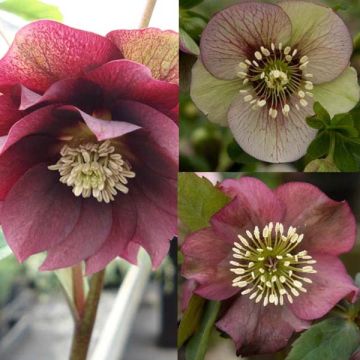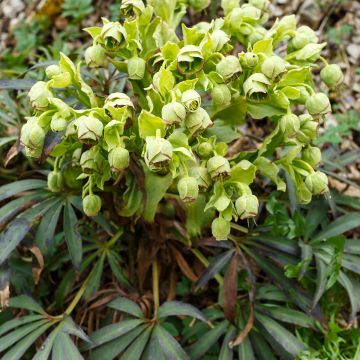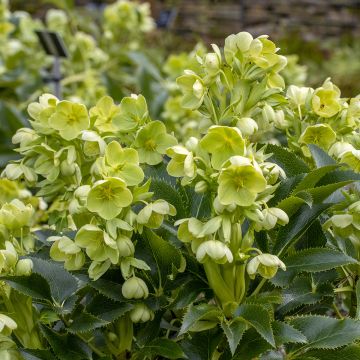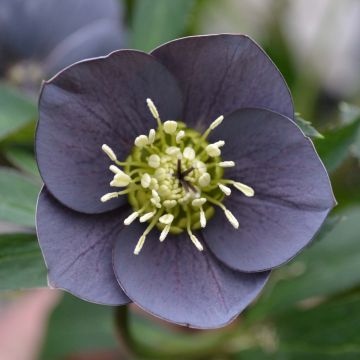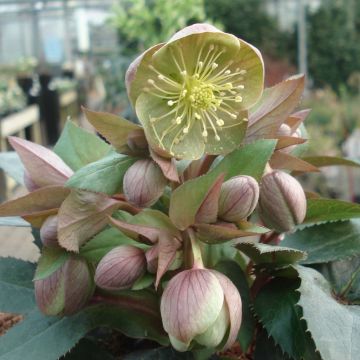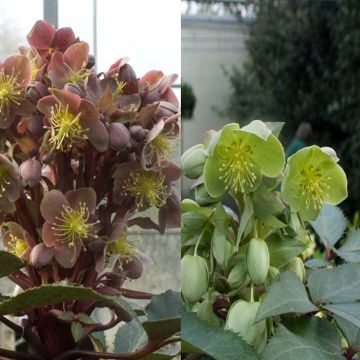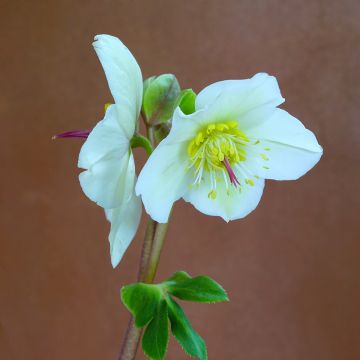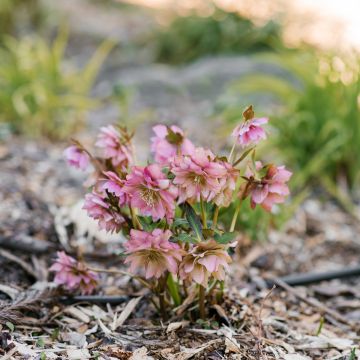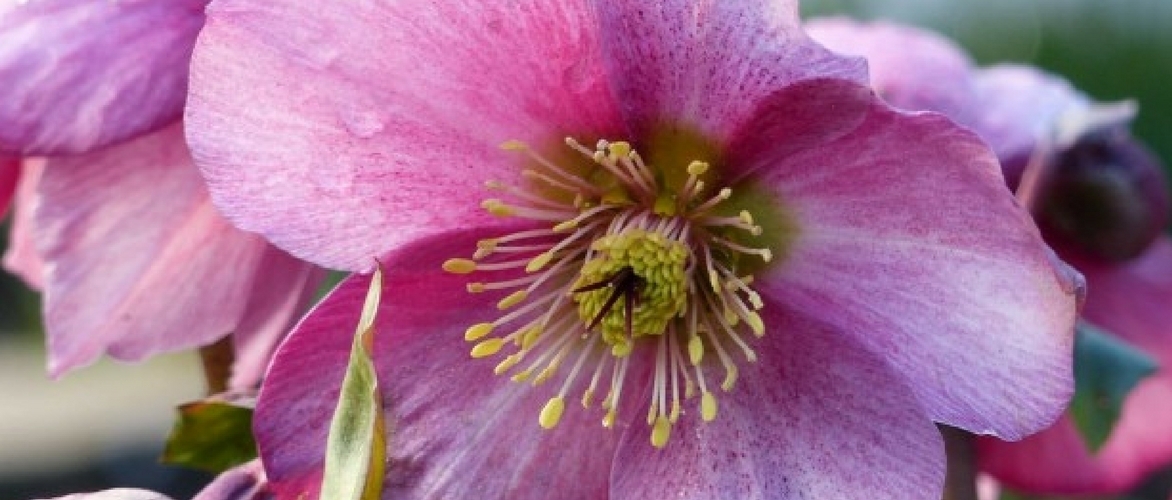
Hellebores: planting, growing
Contents
Hellebores, in a nutshell
- The Hellebore or Christmas Rose is one of the few plants that bloom in the middle of winter: Helleborus niger will provide you with flowers from December, and Helleborus orientalis at the end of winter.
- Very hardy, this perennial withstands cold and shady conditions. It requires fresh, rich, yet well-draining soil.
- Hellebores offer single or double flowers in a wide range of colours: pink, purple, white, yellow, green… There are even varieties with black flowers!
- Its flowers bring colour and brightness to dark and shaded borders.
- Its evergreen foliage, which is highly decorative, varies in fineness depending on the species.
A word from our expert
The Hellebore, sometimes spelled Ellébore, is a perennial plant that stands out by offering a rich display of colour in the middle of winter. The earliest bloomers start flowering in November, while the latest finish in April. The Christmas Rose (Helleborus niger), which produces beautiful white flowers that are sometimes tinged with pink, is the most well-known species. There are also many varieties of Oriental Hellebores, which offer flowers in a variety of colours, both single and double. Also discover the Corsican Hellebore, with its yellow-green flowers and beautiful dentate foliage, surprisingly resistant to sun and drought.
Mysterious, the Hellebore is an astonishing plant in more ways than one. It surprises us with its flowers that can sometimes be green or black, which is quite rare among plants! Its life cycle seems to be inverted compared to other plants. Thus, it awakens in autumn or early winter, then flowers and produces seeds, before going dormant when summer arrives! Moreover, the coloured parts that we believe to be petals are actually sepals, which allows them to last a long time and take on quite rare shades.
Naturally adapted to winter, it is a very hardy perennial, often down to -15 °C. It requires rich, cool, but well-drained soil. It thrives in a semi-shaded position. Planted at the foot of deciduous trees or bushes, it will bring a splash of colour and almost make us forget winter! It is decorative both for its flowers and its evergreen foliage. Once established, Helleborus niger and orientalis have a very long lifespan and are resistant to diseases: you will enjoy their blooms for many years to come!
Its flowers are used in cut arrangements to create bouquets. But be sure to pick fully open flowers (when the nectaries have fallen) unlike other cut flowers!
Botany and description
Botanical data
- Latin name ”Latin
- Common name ”Common
This is a plant that needs time to establish, and most species do not start flowering until two to five years. This is why at Promesse de Fleurs, we only sell Hellebores that are over two years old, ensuring flowering in the first year!
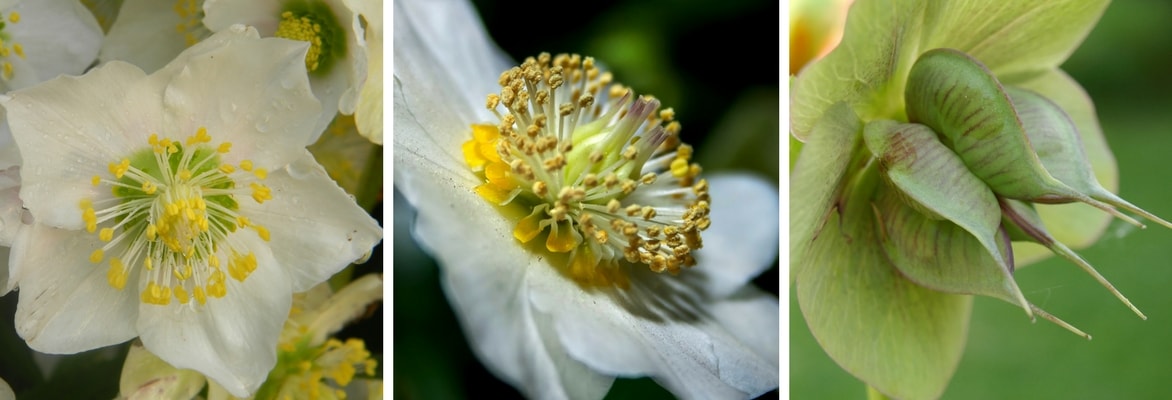
Detail of Hellebore flower
The Hellebore naturally bears white, green, or purple flowers. Thus, the Helleborus purpurascens is a botanical species with beautiful purple flowers. From these species, horticulturists have created numerous hybrids, whose flowers can take on shades of pink, purple, orange, red, and even black (Helleborus orientalis ‘Black’). One of the peculiarities of Hellebores is precisely to offer the possibility of green or black flowers, which is quite rare. There are also bicoloured varieties, delicately speckled with dots, as seen in Helleborus orientalis subsp. guttatus. Others, like Helleborus ‘Picotee’, are veined with purple.
The flowers of Hellebores can be single or double. The single-flowered varieties have a very natural appearance and seem quite close to the botanical species. As for the double-flowered varieties, obtained by transforming the nectaries into petals, they appear very delicate and sophisticated. They resemble true jewels, especially when a fine edging highlights the colour of the petals, as seen in Helleborus orientalis ‘Double Aubergine with White Edge’.
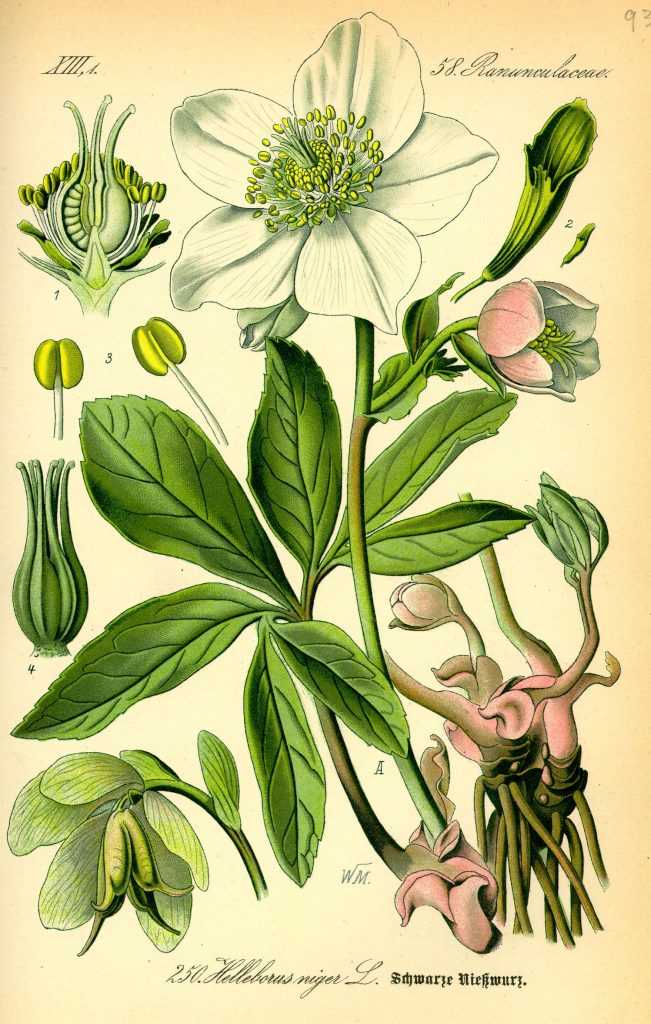
Helleborus niger, botanical plate
The flowers of Hellebores are large, cup-shaped, and often droop towards the ground. They are composed of five sepals, which closely resemble petals. It is thanks to these modified sepals that the flower remains decorative for so long (they have a longer lifespan than petals and do not wilt like them). The petals, on the other hand, have become very discreet and short. They have transformed into nectaries: they contain nectar and thus serve to attract pollinators. They surround the stamens. These are very numerous and can be yellow or white. They are decorative and create a lovely contrast when the flowers are black or dark.
The flowers of Hellebore are melliferous and attract pollinators. They are precious in winter when food is scarce for insects.
Some species bloom as early as November, such as Helleborus foetidus. Others bloom in late winter, such as Helleborus orientalis. The flowers are generally single, but horticulturists have developed a large number of double-flowered varieties (mainly in Helleborus orientalis).
The foliage of Hellebores is often evergreen, although there are also a few deciduous species, such as Helleborus purpurascens. They are large and divided, with a palmate appearance. They have a varying number of segments: thus, the Corsican Hellebore has leaves with three broad, dentate segments, while the stinking hellebore has up to ten fine, elongated segments. In some species, the leaves emerge directly from the ground (basal leaves). In others, like the Corsican Hellebore, they emerge from the stems (cauline leaves).
Hellebores have thick, fleshy roots. They are sometimes black, as in Helleborus niger. Fragile, they must be handled carefully during planting or cultural operations.
The fruits of Hellebores have little ornamental interest. They are follicles, dry fruits that open when ripe. There can be one to fifteen, fused together. They are topped with a long, fine point and contain black seeds that are dispersed by ants. Spontaneous sowing allows for easily obtaining new shapes and colours.
Finally, the Hellebore is known to be toxic. This is true when ingested (but who would have the funny idea of eating it?). It is often advised to handle it with gloves… a precaution that few gardeners take, we assure you!
The species
Botanical Species
- Helleborus foetidus
The fetid hellebore gets its name from the unpleasant smell emitted by its leaves when crushed. It can be found in the wild in France, mainly in undergrowth. It bears small yellow-green flowers with purple edges, drooping towards the ground. Unlike the Oriental hellebore or the Christmas rose, it prefers dry soils. It has beautiful, finely divided evergreen foliage.
→ Learn more with our video on the fetid hellebore
It is known as the Christmas rose, or black hellebore due to the colour of its roots. It is the most well-known species, but also the most delicate to cultivate. It is shorter than other species, measuring 30 cm in height. It offers a beautiful pure white flowering, sometimes pinkish, which brightens its dark green foliage. There are also varieties with double flowers.
- Helleborus argutifolius
This species grows naturally in Corsica and Sardinia, which explains its French name: Corsican hellebore. It is one of the largest species of hellebores, often measuring 50 cm tall, but can reach up to 1.20 m in good conditions and when in flower. From January to April, it offers bright light green flowers. Its stems bear beautiful dark green leaves, usually evergreen, but can be deciduous in harsh winters. This hellebore tolerates full sun and drought. It is ideal if you do not have a shaded spot to grow hellebores!
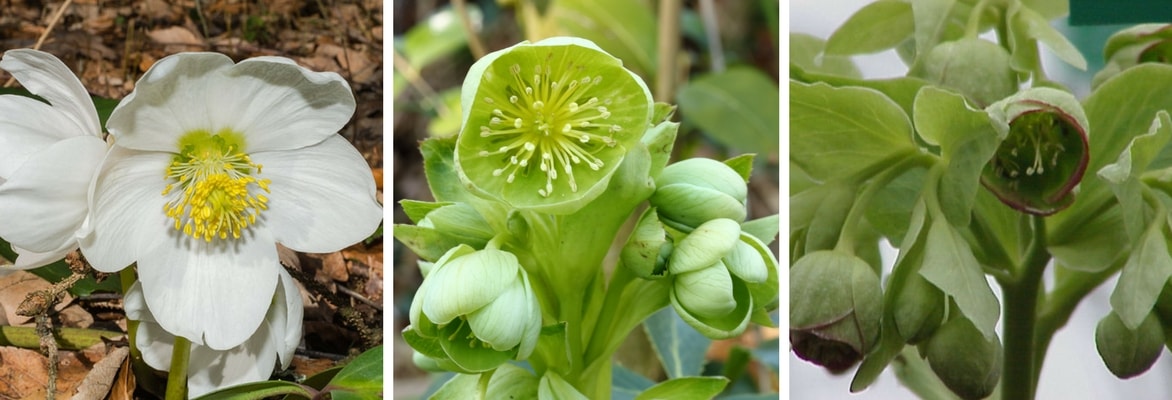
Helleborus niger – Helleborus argutifolius – Helleborus foetidus
- Helleborus orientalis
Also known as the Lent rose, it is one of the most beautiful species, and the one that offers the widest range of colours. There are many hybrids, including stunning varieties with double flowers. All equally beautiful, these cultivars are mainly derived from this species, so much so that botanists have renamed it Helleborus x hybridus.
The Oriental hellebore measures about 50 cm tall. It blooms in late winter, for two to three months. It then bears flowers oriented towards the ground. The petals are cream white, then turn purple-pink, providing a beautiful contrast with the numerous yellow stamens that surround them. Its leaves are evergreen and dark green.
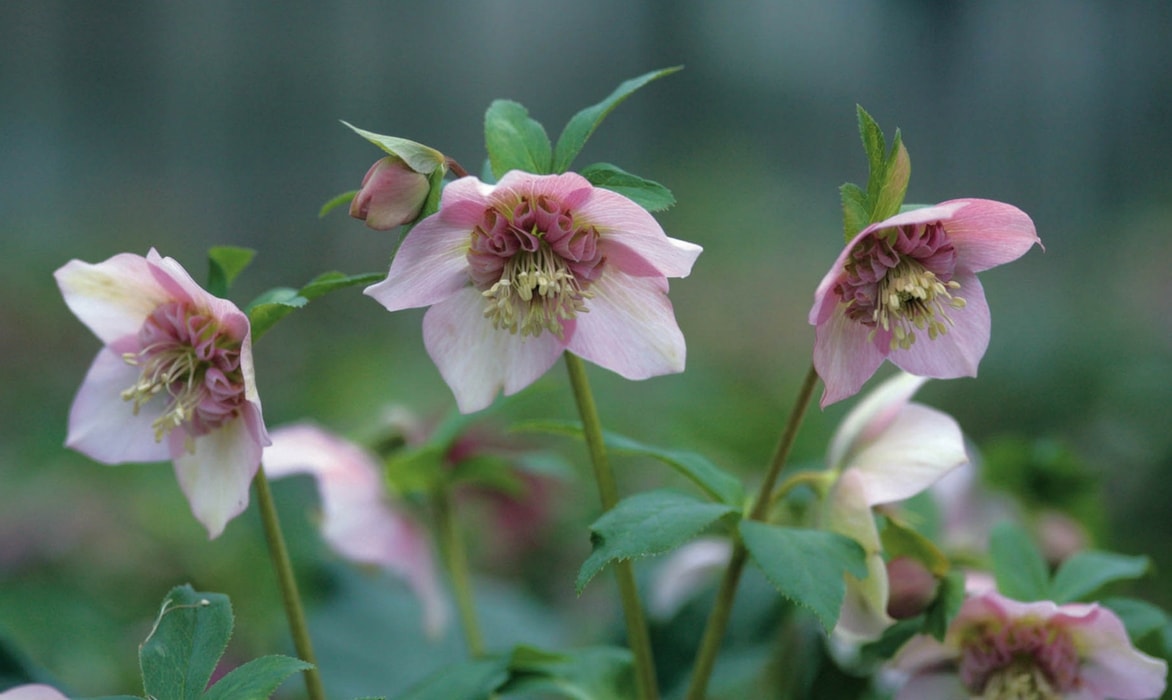
Helleborus orientalis anemone pink
- Helleborus lividus
This species originates from the Balearic Islands, specifically the island of Mallorca. Like the Corsican hellebore, it enjoys sun and dry soils. It reaches 45 cm in height. Its leaves are green with a bluish tint. At the end of winter, it bears green flowers tinged with pink. However, it is less hardy than other species. You can cultivate it if you live in a region with a mild climate.
The Hybrids
This hybrid, resulting from a cross between the Christmas rose and the Corsican hellebore, is cultivated for both its numerous white flowers and its decorative, evergreen foliage. It is a very vigorous and resilient variety.
- Helleborus x sternii
This hybrid results from a cross between Helleborus argutifolius and Helleborus lividus. Its parents being native to Corsica and the Balearic Islands, it tolerates full sun and dry soils. In late winter, it bears pale green flowers, more or less pinkish. Its blue-grey foliage with pale veins is borne on burgundy stems.
Discover other Helleborus - Hellebore
View all →Available in 0 sizes
Available in 0 sizes
Available in 1 sizes
Available in 2 sizes
Available in 2 sizes
Available in 2 sizes
Available in 0 sizes
Available in 1 sizes
Available in 1 sizes
Available in 1 sizes
The main varieties of hellebores
Horticulturists have produced a large number of hybrids, often from Helleborus orientalis. However, it should be noted that the colours of their flowers can vary slightly. They are not always stabilised, as Hellebores are obtained by sowing, rather than by vegetative propagation (propagation by cuttings, etc.), which is the only technique that allows for the production of strictly identical plants.

Helleborus ericsmithii Magic Leaves
- Height at maturity 30 cm
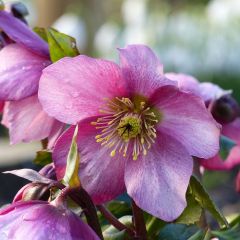
Helleborus Madame Lemonnier
- Height at maturity 30 cm
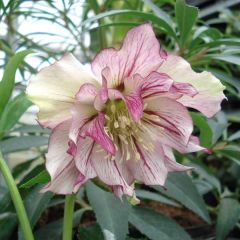
Helleborus hybridus Double Picotee
- Flowering time February to April
- Height at maturity 40 cm
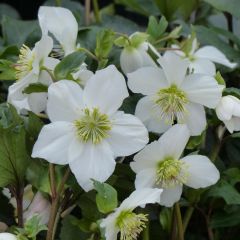
Helleborus x lemonnierae 'HGC Paradenia'
- Flowering time February to April
- Height at maturity 30 cm
Most varieties of Hellebores are not stabilised and can therefore have a colour that varies very slightly.
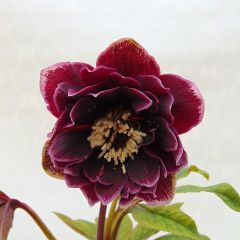
Helleborus hybridus Double Aubergine White Edge
- Flowering time March to May
- Height at maturity 40 cm
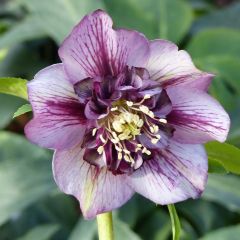
Helleborus hybridus Anemone Picotee
- Flowering time February to May
- Height at maturity 40 cm

Helleborus Madame Lemonnier
- Height at maturity 30 cm
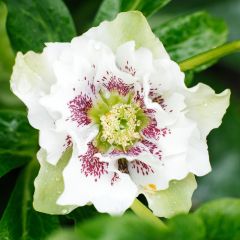
Helleborus hybridus Double White Spotted
- Flowering time March to May
- Height at maturity 40 cm

Helleborus hybridus Anemone Green
- Flowering time March to May
- Height at maturity 40 cm
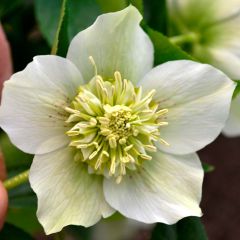
Helleborus hybridus Anemone White
- Flowering time March to May
- Height at maturity 40 cm
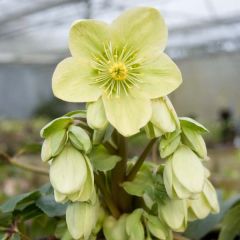
Helleborus nigercors Snow Love
- Flowering time March, April
- Height at maturity 30 cm
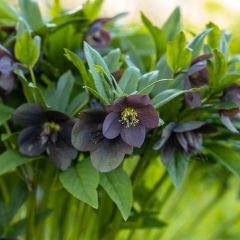
Helleborus x hybridus Black
- Flowering time March to May
- Height at maturity 40 cm

Helleborus niger Double Fashion - Christmas Rose
- Height at maturity 40 cm
/]
To choose your Hellebores well, follow our advice: “Hellebore or Christmas Rose: which variety to choose”
Read also
Hellebores: 7 successful pairing ideasHow to plant a hellebore
Where to plant?
The Hellebore prefers clayey, heavy soils that are well-drained: your soil should not be waterlogged in winter. However, it should remain cool even in summer. The Hellebore thrives in rich, humus-bearing soils. If your soil is rather poor, add organic matter or compost to enrich it. It prefers calcareous soils, and the Christmas Rose, Helleborus niger, does not tolerate acidic ground. In contrast, the Oriental Hellebore enjoys acidic soil.
It prefers slightly shaded locations and does not like direct sunlight. The best option is to plant it under deciduous bushes. This way, they will protect it from the sun during summer while allowing light to filter through in winter. It also looks great at the base of trees and shrubs. However, note that the Corsican Hellebore (Helleborus argutifolius) and Helleborus x sternii prefer sunlight and seem to tolerate drought better than other species.
We also recommend planting your Hellebores in a sheltered position from the wind.
When to plant?
Hellebores are planted in spring or autumn, both of which are suitable periods for their rooting. Autumn is often preferred as temperatures are milder and humidity is more consistent, promoting good establishment before winter. It is important to plant outside of frost periods, which can compromise the development of young plants.
How to plant?
Plant your Hellebores in groups of 3 or 5 plants, while maintaining a distance of 50 to 60 cm between each plant. Feel free to place them on a slight mound, as this will prevent water from stagnating in winter.
If your soil is acidic, you can raise the pH by adding dolomite (crushed sedimentary rock rich in lime). If it is clayey, add gravel or clay balls to make it more draining.
Here are the steps to plant a hellebore:
- Moisten the root ball by soaking it in a basin of water.
- Dig a hole twice as wide as the root ball.
- If the soil is heavy, add a layer of gravel or coarse sand at the bottom for drainage.
- Enrich the soil with potting soil or compost.
- Place the root ball, keeping the collar level with the soil or slightly above.
- Fill in with a mixture of garden soil, potting soil, and sand, then gently firm it down.
- Water generously.
If you are using young plants, often found in garden centres in buckets of less than 1 litre, your Hellebores may take a long time to settle in. Sometimes they may take up to two years before flowering! At Promesse de Fleurs, the plants offered are over two years old, ensuring you a bloom in the first year.
How to care for Hellebore?
Even in summer, when Hellebores are in their vegetative rest and could easily be forgotten, it is better to water them to prevent them from completely drying out. We also recommend mulching by placing a layer of dead leaves at the base of the Hellebores to keep the soil cool and for a more attractive visual effect.
When the flower buds appear, remove the old leaves. This helps to highlight the new flowers, as the leaves could otherwise obscure them. Additionally, cutting back the old leaves helps to limit the risk of fungal diseases, particularly black spot disease caused by the fungus Marsonia.
 When the buds appear, remove the old leaves!
When the buds appear, remove the old leaves!
The Hellebore is indeed sensitive to black spot disease, grey mould, and collar rot. These diseases are signs of excess moisture. Treat with Bordeaux mixture and consider relocating the plant to a more draining soil. Regarding pests, it is particularly susceptible to aphids! However, its leaves are also sometimes eaten by slugs and snails.
The Hellebore enjoys rich soils: we recommend incorporating ground horn, well-rotted manure, or compost on the surface. This helps to nourish the plant. Apply fertiliser if you have planted in a pot.
If you have planted the Christmas Rose, Helleborus niger, you can also spread wood ash to slightly raise the pH. Remember, this Hellebore prefers rather calcareous soils!
→ Learn more with Diseases and pests of Hellebores
Possible diseases and pests
Hellebores, although quite robust, can be affected by several diseases and pests. Among the most common diseases, there is black spot disease (Coniothyrium hellebori). This manifests as dark spots on the leaves, which can lead to yellowing and the dropping of affected leaves. Another common disease is downy mildew, which causes yellowish spots on the leaves, sometimes followed by wilting. Finally, botrytis, a grey mould, can also affect Hellebores, especially in humid conditions.
As for pests, aphids can suck the sap from young shoots, thereby weakening the plant. Slugs and snails also love the tender young leaves of Hellebores, causing holes and significant damage.
To avoid these problems, it is essential to maintain good air circulation around the plants by avoiding overly dense planting. Moderate watering is recommended, as Hellebores do not like excessive moisture that encourages fungi.
→ To learn more about how to avoid all these little inconveniences, read Diseases and Pests of Hellebore.
Multiplication: sowing, division
To multiply Hellebores, two techniques are possible: sowing or clump division.
Sowing Hellebores
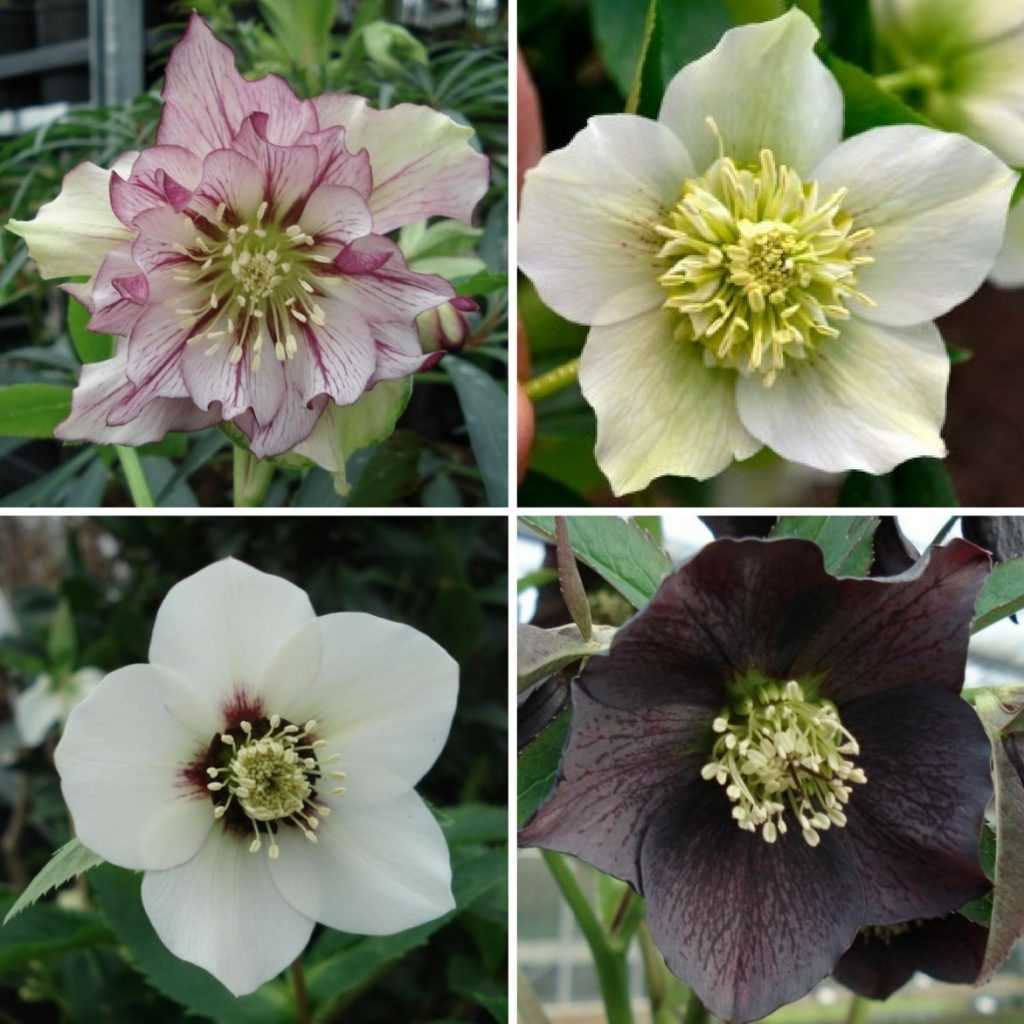
Helleborus orientale Double Picotée / Pure White Anemone / White with red centre / Black: stunning but not reproducible by sowing.
Sowing Hellebores is not particularly complicated to carry out. However, it is essential to follow a few simple rules and, above all, to sow the seeds very quickly: they do not store well!
When multiplying Hellebores by sowing, it is not possible to be certain of obtaining a plant that is strictly identical to the parent plant. Colour variations may occur. Furthermore, you will need to be patient and wait a few years for them to flower. Some hybrids like Helleborus x nigercors cannot be multiplied by sowing as they are sterile.
Sowing is, however, the only solution to reproduce the Stinking Hellebore, the Majorcan Hellebore, and the Corsican Hellebore, as they do not multiply by clump division. Fortunately, the Corsican Hellebore self-seeds very easily!
Sowing in pots, under cover:
The seeds do not last long. They should be sown as soon as possible as they lose their seed viability very quickly.
- Start by placing the seeds in the refrigerator for 10 to 15 days. They need this cold period to germinate.
- Fill a pot with seed compost.
- Place a few seeds on the surface.
- Cover them with a thin layer of compost.
- Lightly firm down.
- Water gently to moisten the substrate without saturating it.
- Place the pot under cover, in a bright location, and ensure that the soil remains constantly moist, but not waterlogged.
Sowing in open ground:
Sowing in situ is possible and very simple as it just requires covering the seeds that have fallen at the foot of the Hellebore with compost. When they have grown, the following year, you can move the clumps to another location.
You will need to wait two to three years before seeing them flower.
Clump Division
Clump division is a technique that offers the advantage of being quicker and more reliable than sowing. We recommend dividing Hellebores in early spring, after flowering. The Oriental Hellebore is preferably multiplied in late summer or early autumn. Only intervene on the largest clumps, and do so carefully, as Hellebores do not tolerate being transplanted well. Their roots are very sensitive and fragile.
- Choose the clump to divide from the largest ones, it should be at least four or five years old.
- Determine the perimeter using a spade by encircling the entire plant.
- Dig and carefully remove the clump from the soil, keeping as many roots intact as possible.
- Gently shake the clump to remove excess soil.
- Divide the root system in two (or more, depending on size) with a clean, sharp knife.
- Replant the new plants immediately.
- Water generously to aid rooting.
It is possible that flowering may be quite poor the following year.
→ Learn more about multiplying Hellebores in our advice sheet and about dividing Hellebores in our tutorial!
Associating Hellebores in the Garden
Hellebores are interesting for their winter flowering, but also for their evergreen foliage, which can be very decorative! You can pair Helleborus x nigercors ‘Magic Leaves’ with its original, white-marbled green foliage, alongside evergreen ferns, such as Dryopteris erythrosora, and some Heucheras with very colourful leaves.
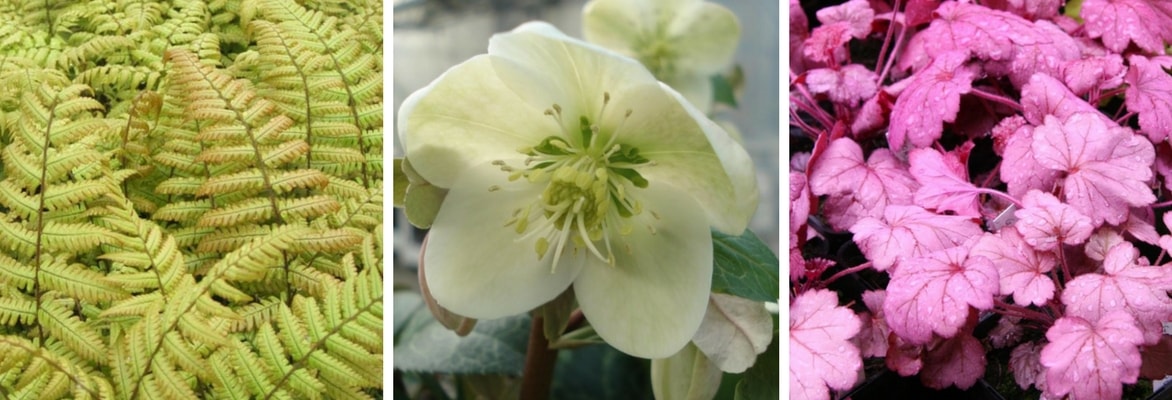
A vibrant combination: Dryopteris erythrosora, Hellebore ‘Magic Leaves’ and Heuchera ‘Georgia Plum’
Because they enjoy being planted in semi-shaded areas, hellebores thrive under deciduous trees and bushes. They protect them from the sun in summer while allowing light to filter through in winter. You can plant them at the base of witch hazels, which have stunning yellow winter flowers. Hellebores also pair very well with trees and shrubs that have decorative wood, such as Prunus or Cornus.
Corsican hellebores and stinking hellebores can be planted in a rockery, as they prefer dry, stony soils and can tolerate sunny exposures. Plant some clumps of grasses alongside them: Carex or Stipa.
Choose hellebores that flower in late winter, such as Helleborus orientalis, and opt for colourful varieties (e.g. Helleborus orientalis guttatus Yellow). Pair them with spring bulbs, such as Snowdrops, Daffodils, or Muscari. Add some Winter Aconites, as they will cover the ground with their beautiful star-shaped yellow flowers. This will give you a vibrant garden as early as February.
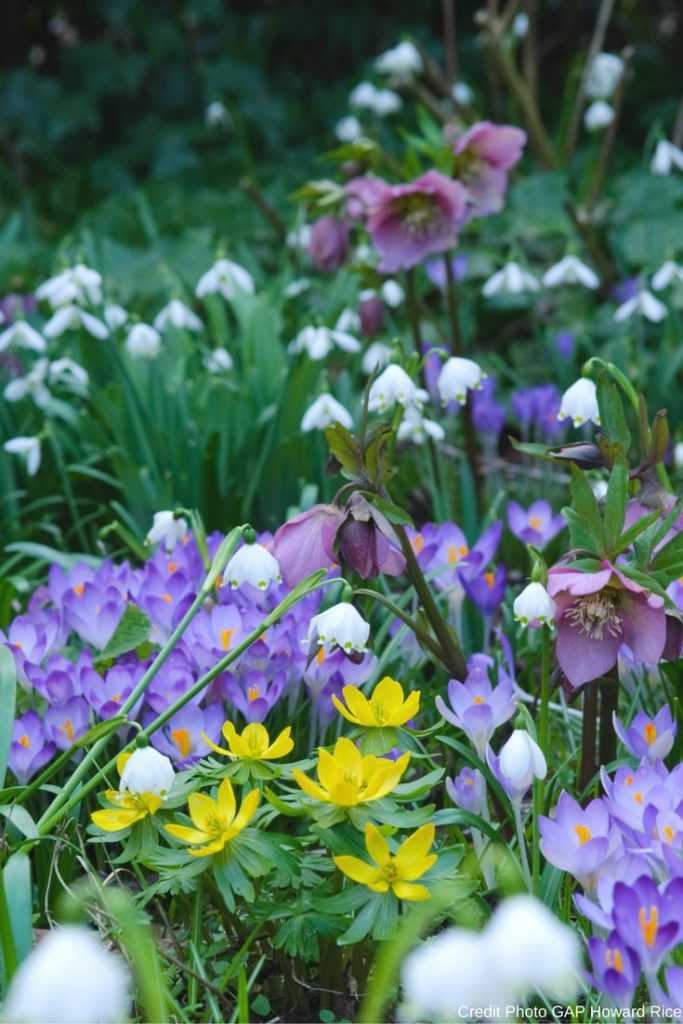
Crocus tommasinianus-Eranthis hyemalis-Leucojum vernum and Helleborus x hybridus
Find more successful pairing ideas in our association sheet: “Hellebores: 7 ideas for successful pairings”
Useful resources
- The most beautiful varieties are with us: discover our wide collection of Hellebores!
- Our tips: “Caring for Oriental Hellebores in 5 simple steps” on our blog and 7 tips for beautiful Hellebores.
- Article by Didier Willery on Hellebores, published in L’Ami des Jardins et de la Maison:
- Website dedicated to botanical Hellebores and Peonies, with growing guides and specific sheets
- Our advice sheets:
- “Hellebores: the sure values”
- 7 Hellebores with anemone flowers
- 6 Hellebores with double flowers
- 7 Oriental Hellebores: the darkest
- 10 Hellebores with single flowers
- botanical Hellebores
- Bicoloured Hellebores: 7 varieties to discover
- Adopt purple-flowered Hellebores to brighten up winter!
- Grow yellow-flowered Hellebores to brighten winter!
- For a colourful winter, choose pink-flowered Hellebores!
- White-flowered Hellebores: perfect for winter!
- Animate the garden at the end of winter with late Hellebores
- To discover: green flowers!
- Learn more about growing Hellebores in pots in Gwenaëlle’s advice sheet
- Our advice sheet: Hellebore lemperii is now in our catalogue! and a new generation of Hellebore in our collection
- Discover our tutorial: When and how to prune Hellebores?
Frequently asked questions
-
Help, my Hellebore isn't flowering!
It is probably too young. Hellebores take a long time to settle in. Sometimes they need more than two years before they can flower! If it is an older young plant, it is possible that the situation is too shaded or that the soil is too dry. Check that its growing conditions are suitable! And be patient… Even though Christmas Roses (Helleborus niger) can flower as early as November or December, it can happen that their flowering only appears from January. Similarly, some species flower later: you will have to wait until March to enjoy the flowers of Oriental Hellebores!
-
The leaves of my Hellebore are falling off!
Hellebores are sensitive to fungal diseases, particularly black spot disease. The leaves rot in cases of excess moisture or if the plant is placed in soil that is too heavy. Consider relocating it to a more favourable position. When planting, create drainage by placing gravel or clay balls at the bottom of the planting hole. You can also plant the Hellebore on a slight mound.
-
The leaves of my Hellebore are drying out... Why?
If they dry out in autumn, there is no need to worry! The old leaves will be replaced in spring by new ones. However, if this happens at another time, the soil is likely too dry! Place a mulch of dead leaves at the base of your Hellebores to retain soil moisture. In summer, you can carry out some watering in case of drought.
-
The colour of the flowers is different from what was expected.
If you obtained the plant through sowing, this is classic and inevitable. Horticultural varieties are not fixed, and colours can vary. Over generations and sowings, the flowers evolve and their colours change slightly, resembling more and more the natural species of Hellebores. However, if it is a young plant that you purchased from us and the difference is very marked, please contact us! We will refund or replace the plant.
-
Can I plant Hellebore during winter?
Yes, you can plant your Hellebore during winter, as long as you do so outside of severe frost periods. However, this depends on the varieties: some species, such as Helleborus lividus, will tolerate it less well.
-
Can I keep my Hellebore indoors?
Yes, you can keep your Hellebore indoors for a few days to fully enjoy its flowering, but not beyond that! It needs coolness and a sufficiently airy location.
- Subscribe!
- Contents
































